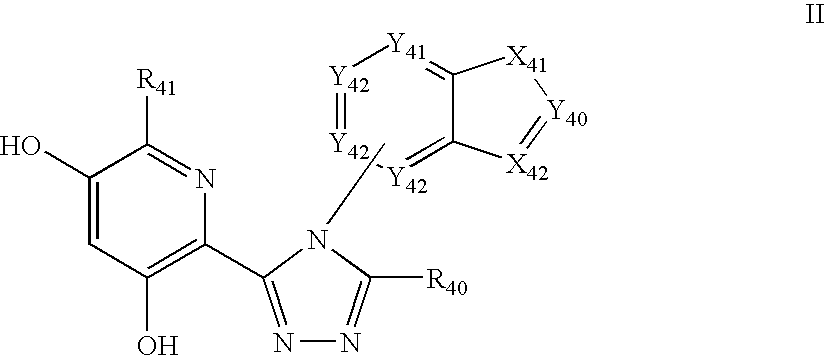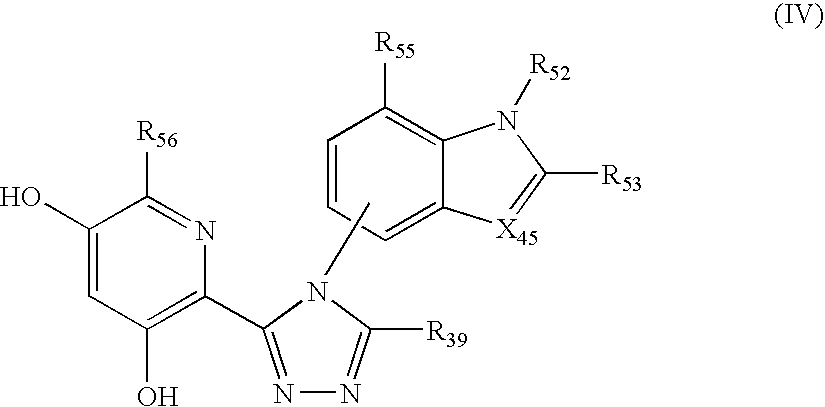Triazole compounds that modulate Hsp90 activity
a technology of hsp90 activity and triazole, which is applied in the direction of antibacterial agents, immunological disorders, drug compositions, etc., can solve the problems of low oral bioavailability, limited solubility, and difficult formulating
- Summary
- Abstract
- Description
- Claims
- Application Information
AI Technical Summary
Benefits of technology
Problems solved by technology
Method used
Image
Examples
example 1
2-Ethyl-6-[5-mercapto-4-(1-methyl-1H-indol-5-yl)-4H-[1,2,4]triazol-3-yl]-pyridine-3,5-diol
[0976]1H-NMR (MeOD): 7.47 (d, 1H); 7.37 (d, 1H); 7.22 (d, 1H); 7.03 (dd, 1H); 6.83 (s, 1H); 6.43 (dd, 1H); 3.79 (s, 3H); 2.61 (q, 2H); 0.95 (t, 3H); MS: expected ion=367.2; observed ion=368.1.
[0977]2,6-dibromo-3,5-dimethoxypyridine: A flask was charged with 3,5-dimethoxypyridine (13 g; 93 mmol), water (100 mL) and concentrated hydrochloric acid (8 mL; ˜1 eq.). To a separate flask was added potassium bromide (65 g.), water (200 mL) and sulfuric acid (69 g.). To a third flask was added potassium bromate (18 g.), and water (1.2 liters). All flasks were stirred until they were homogenous. To the flask with potassium bromate was added the solution containing potassium bromide, followed by the solution containing the pyridine compound. The reaction was stirred for ten minutes, and a solution of sodium sulfite was added until the orange color disappeared. The solid was collected by Buchner funnel, was...
example 2
4-Isopropyl-6-[4-(1-methyl-1H-indol-5-yl)-5-phenylamino-4H-[1,2,4]triazol-3-yl]-benzene-1,3-diol (Compound 1a)
[0986]1H-NMR (CDCl3): 7.70 (d, 1H); 7.59 (d, 1H); 7.50 (m, 3H); 7.29 (m, 2H); 7.22 (dd, 1H); 6.98 (m, 1H); 6.62 (d, 1H); 6.40 (s, 1H); 6.28 (s, 1H); 3.94 (s, 3H); 2.83 (q, 1H); 0.57 (d, 3H); 0.44 (d, 3H). MS: expected ion=439.2; observed ion=440.4.
[0987][5-(5-Isopropyl-2,4-dimethoxy-phenyl)-4-(1-methyl-1H-indol-5-yl)-4H-[1,2,4]triazol-3-yl]-phenyl-amine: A flask was charged with 5-isopropyl-2,4-dimethoxy-N-(1-methyl-1H-indol-5-yl)-thiobenzamide (123 mg; 0.33 mmol), dioxane (2 mL), and hydrazine (0.5 mL). The reaction was heated to 100° C. for one hour, and the solvent was removed by evaporation. To the solid cake was added ethyl acetate (10 mL) and 10% aqueous potassium carbonate (1 mL), and it was shaken until the solid was completely dissolved. The organic layer was isolated, and dried with sodium sulfate. To the crude intermediate in the organic layer was added diisopropy...
example 3
4-Isopropyl-6-[4-(1-methyl-1H-indol-5-yl)-5-methylamino-4H-[1,2,4]triazol-3-yl]-benzene-1,3-diol (Compound 2a)
[0989]1H-NMR (CDCl3): 7.60 (d, 1H); 7.51 (d, 1H); 7.23 (d, 1H); 6.56 (d, 1H); 6.41 (s, 1H); 6.30 (s, 1H); 3.88 (s, 3H); 3.03 (d, 3H); 2.79 (q, 1H); 0.57 (d, 3H); 0.45 (d, 3H). MS: expected ion 377.2; observed ion=378.4. Compound 2a was synthesized in a fashion analogous to Compound 1a.
PUM
| Property | Measurement | Unit |
|---|---|---|
| structure | aaaaa | aaaaa |
Abstract
Description
Claims
Application Information
 Login to View More
Login to View More - R&D
- Intellectual Property
- Life Sciences
- Materials
- Tech Scout
- Unparalleled Data Quality
- Higher Quality Content
- 60% Fewer Hallucinations
Browse by: Latest US Patents, China's latest patents, Technical Efficacy Thesaurus, Application Domain, Technology Topic, Popular Technical Reports.
© 2025 PatSnap. All rights reserved.Legal|Privacy policy|Modern Slavery Act Transparency Statement|Sitemap|About US| Contact US: help@patsnap.com



